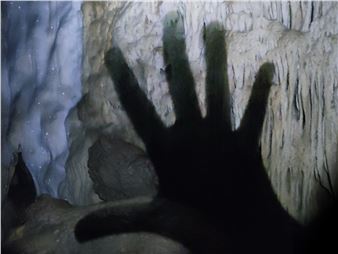Marlon Wobst: Tides
A complete tidal cycle takes about 24 hours and 50 minutes. That means the low and high tides begin every day at a different time. Various factors influence differently strong tides вҖ“ the interrelationship of moon, sun, and earth is the most important factor for the study of tides. And even though little is as certain as the return of low and high tides, they are never the same , and always to a certain degree unpredictable.
In the nine works that Marlon Wobst presents at Galleri KANT, the variations of this repetitive phenomenon are brought to the canvas very clearly. As if they symbolized the always same basic conditions, all paintings are the same size. In them, the seaвҖҷs variable moods are shown: sometimes it is night and sometimes it is day, sometimes uncertain and dark, at other times suffused with light and azure. The colour and dynamic of the sea вҖ“ or is that already the sky? вҖ“ seem never the same: here agitated and discomforting, there glitteringly turquoise and calm. In WobstвҖҷs paintings, spatial depth, above and below, and all directions merge into a highly descriptive mass. And yet, details can be made out: a few boats, a school of fish, pink clouds, an old bicycle. Like in a crowded picture for children, the artist rehearses in his works the reduction to the essential.
On the canvas, irregular layers of paint point to the fact that in these places there were things that Wobst painted over. In this way, the artist reveals to the beholders a part of his painting process and at the same time makes the successive changes in the painting visible. In this way, he accentuates what was, shows past and present in one painting, as if they happened at the same time.
With an almost investigative interest, Marlon Wobst asks: what does a swimmer look like from below? Or from the side? How does one show weightlessness? The people on the canvas remain anonymous, they seem to sink into the enormous colour fields. The eye of the beholder is unable to make out a fixed point вҖ“ similar to the bodies and their limbs shown in the paintings, it is adrift. Therefore it isnвҖҷt surprising that looking at WobstвҖҷs paintings leads to a certain state of relaxation.
Through human interventions like harbours and piers, the effects of the tides can be limited and supposedly controlled. WobstвҖҷs works convey the opposite of this approach: TIDES is the documentation of something that cannot really be grasped. The people forego control, simply swimming with the current. Although they float aimlessly, nobody is completely lost in the paintings by Marlon Wobst. The people are individual painterly markings in a purely accidental interplay. It may look like order for a brief moment вҖ“ until the next wave.

A complete tidal cycle takes about 24 hours and 50 minutes. That means the low and high tides begin every day at a different time. Various factors influence differently strong tides вҖ“ the interrelationship of moon, sun, and earth is the most important factor for the study of tides. And even though little is as certain as the return of low and high tides, they are never the same , and always to a certain degree unpredictable.
In the nine works that Marlon Wobst presents at Galleri KANT, the variations of this repetitive phenomenon are brought to the canvas very clearly. As if they symbolized the always same basic conditions, all paintings are the same size. In them, the seaвҖҷs variable moods are shown: sometimes it is night and sometimes it is day, sometimes uncertain and dark, at other times suffused with light and azure. The colour and dynamic of the sea вҖ“ or is that already the sky? вҖ“ seem never the same: here agitated and discomforting, there glitteringly turquoise and calm. In WobstвҖҷs paintings, spatial depth, above and below, and all directions merge into a highly descriptive mass. And yet, details can be made out: a few boats, a school of fish, pink clouds, an old bicycle. Like in a crowded picture for children, the artist rehearses in his works the reduction to the essential.
On the canvas, irregular layers of paint point to the fact that in these places there were things that Wobst painted over. In this way, the artist reveals to the beholders a part of his painting process and at the same time makes the successive changes in the painting visible. In this way, he accentuates what was, shows past and present in one painting, as if they happened at the same time.
With an almost investigative interest, Marlon Wobst asks: what does a swimmer look like from below? Or from the side? How does one show weightlessness? The people on the canvas remain anonymous, they seem to sink into the enormous colour fields. The eye of the beholder is unable to make out a fixed point вҖ“ similar to the bodies and their limbs shown in the paintings, it is adrift. Therefore it isnвҖҷt surprising that looking at WobstвҖҷs paintings leads to a certain state of relaxation.
Through human interventions like harbours and piers, the effects of the tides can be limited and supposedly controlled. WobstвҖҷs works convey the opposite of this approach: TIDES is the documentation of something that cannot really be grasped. The people forego control, simply swimming with the current. Although they float aimlessly, nobody is completely lost in the paintings by Marlon Wobst. The people are individual painterly markings in a purely accidental interplay. It may look like order for a brief moment вҖ“ until the next wave.

 ARTISTS
ARTISTS











